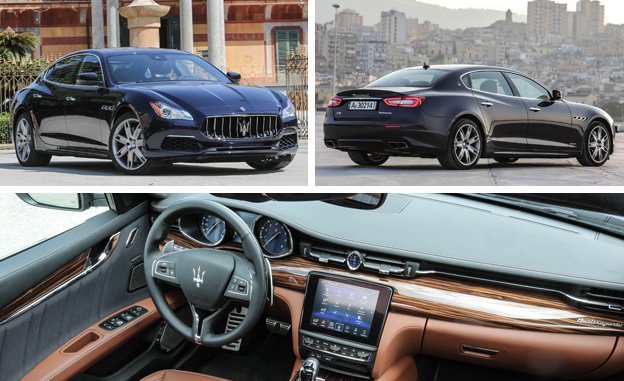It’s clear that things have changed in the luxury market when Lexus and Acura are getting all sorts of attention for sexy new sports coupes while Maserati concentrates on luxury sedans and even—gasp—an SUV. A recent (and ambitious) plan for global sales growth has left Maserati’s sole sports coupe grand tourer, aptly named the GranTurismo, largely neglected while the Ghibli and Quattroporte sedans and the Levante SUV take priority. But the plan is working so far: Maserati sales have soared in recent years, and the impending arrival of the new Levante should keep the good times going.
So now that Maserati has fleshed out its lineup, it’s finally time for a new sports coupe, right? Wrong. A next-generation coupe continues to sit on the back burner while the full-size Quattroporte luxury sedan goes under the knife for its mid-cycle refresh, with the mid-size Ghibli soon to follow. Although this update for 2017 leaves the car’s chassis and engines alone, it does include noteworthy changes that go beyond visual freshening. Revised transmission tuning and new sound-deadening materials aim for greater refinement, and a whole host of new active safety features at least put the Quattroporte in the same technology conversation as German establishment competitors such as the BMW 7-series and Mercedes-Benz S-class.
As Italian as Pavarotti
Don’t think that these revisions have done anything to temper the Maserati’s distinctly Italian character. The Quattroporte still is a lusty car, more outwardly sporty than anything in its segment save for perhaps the Jaguar XJR. In the hills of Sicily, its responses were sharp for such a large sedan (the Quattroporte measures 207.2 inches long, one inch longer than a 7-series), thanks to a firm suspension setup that keeps body motions tightly controlled. Especially in the V-8–powered Quattroporte GTS that we drove for most of a day, the steering is particularly delightful: It’s heavy, but not overly so, and provides a good amount of feedback from the road.
The V-8, a 3.8-liter twin-turbocharged unit making 523 horsepower and 524 lb-ft of torque, produces a tuneful soundtrack and smooth power delivery throughout the rev range. Maserati says it has quickened the shifts from the ZF eight-speed automatic transmission; kickdowns indeed were crisply executed and throttle response was swift as we charged up mountain roads and passed slow-moving Fiat hatchbacks on the autostrada.
The V-6–powered, all-wheel-drive Quattroporte S Q4, which makes up around 60 percent of Quattroporte sales in the U.S., isn’t quite as red-blooded and satisfying to drive as the GTS. Power delivery from the V-6 is less immediate, and the lighter engine up front means that its steering doesn’t feel as well-connected to the road. Even so, the 3.0-liter, twin-turbocharged engine with 404 horsepower and 406 lb-ft of torque provides plenty of thrust higher in the powerband, and its higher-pitched, tenore engine note is just as sultry and pleasing as the V-8’s basso profundo. For around $35,000 less than the GTS, the V-6 Quattroporte’s slight dynamic tradeoffs don’t add up to much—but then again, shouldn’t a Maserati be all about excess?
Mixed Messages
Regardless of engine choice, the Quattroporte is a six-figure car (pricing hasn’t yet been announced, but should be a bit higher than the outgoing car’s $101,700 starting price). It looks the part on the outside, too; its refreshed front end makes a stronger statement with a more prominent grille and extra chrome flourishes. The rear end looks more generic, but the attractive multi-spoke, 21-inch wheels (standard on the new-for-2017 GranSport trim level) and swoopy side surfacing give the Maserati an undeniable presence.
It’s not quite the same story inside. Yes, there are some ergonomic improvements for 2017, most notably the addition of Apple CarPlay and Android Auto capabilities. There’s also a new rotary control knob behind the shifter that adds some appreciated redundancy to the touchscreen infotainment system (essentially a spruced-up version of Chrysler’s Uconnect interface). And yes, Maserati does use undeniably luxurious materials such as soft leather, available Ermenegildo Zegna silk inserts, and either real carbon fiber or various wood trims depending on option choices.
Yet several oddities remain. An extraordinarily shallow center console may not even be able to accommodate some smartphones. The larger touchscreen’s glass cover is a magnet for unsightly fingerprints. The massive metal shift paddles annoyingly obstruct the driver’s access to the combination turn-signal/windshield-wiper stalk, which, by the way, is the same one you’ll find in a Jeep Cherokee. And that’s not the only interior piece that Quattroporte owners will recognize when they rent other Fiat-Chrysler products while on vacation: the window switches, starter button, the headlight control knob, and instrument-cluster display screen all come from the FCA corporate parts bin. Interior pieces of this quality simply wouldn’t pass muster in any Audi, Mercedes-Benz, or BMW, and they aren’t befitting of a car that can cost upwards of $150,000.
Still an Interesting Alternative
And yet we can certainly see the appeal of telling your neighbors that the sexy new sedan in your driveway is called a Maserati Quattroporte. Maserati asserts that its customers are seeking something different from the German establishment offerings, and the Q’porte’s distinctive character continues to be its strongest asset. But those interior niggles and emphasis on sportiness rather than comfort means that you’re making a sacrifice for exclusivity and specialness. It’s a tradeoff that some are willing to make, but it’s a questionable set of priorities in the luxury-sedan segment. Now, how about that upcoming Maserati sports coupe?
Powered by WPeMatico







